Local Failure Modes and Critical Buckling Loads of a Meta-Functional Auxetic Sandwich Core for Composite Bridge Bearing Applications
Abstract
:1. Introduction
2. A Numerical Model for an Auxetic Sandwich Core Used for Bridge Bearings
2.1. An MFAU Cell Computer-Aided Design (CAD) Model
2.2. Effective Poisson’s Ratio of the MFAU Cell Model
3. Materials and Methods
3.1. Analytical Analysis
3.2. Numerical Analysis
4. Results
4.1. Analytical Results
4.2. Numerical Results
5. Conclusions
- Local buckling failure can potentially appear before yielding in the vertical and diagonal columns of the MFAU cell under compression.
- The comparative results of the critical buckling load analysis of the vertical and diagonal column between the analytical solutions and the numerical predictions are in good agreement, with less than 0.70% and 0.62%, respectively, when the TPU material is in a linear elastic regime.
- The failure curve of the MFAU cell model has been identified in order to predict its local buckling phenomena based on the slenderness ratios.
- For bridge bearing applications, the overall compressive behaviour of the MFA composite bridge bearing model shows auxetic behaviour (contraction), with promising crashworthiness under compression.
- For additive manufacturing, the findings in this paper indicate that the MFA composite bridge bearing model using a proposed material can, when compared to experimental results, perform well under compression as a common bridge bearing. Thus, fabrication by 3D printing and the development of this design for application could be possible for practical use in the near future.
Author Contributions
Funding
Institutional Review Board Statement
Informed Consent Statement
Data Availability Statement
Acknowledgments
Conflicts of Interest
References
- AASHTO. Guide Specifications for Seismic Isolation Design, 3rd ed.; American Association of State Highway and Transportation Officials: Washington, DC, USA, 2010. [Google Scholar]
- CSA. S6-14—Canadian Highway Bridge Design Code; Canadian Standards Association: Toronto, ON, Canada, 2014. [Google Scholar]
- Priestley, M.; Calvi, G.; Kowalsky, M. Displacement-Based Seismic Design of Structures; IUSS Press: Pavia, Italy, 2007. [Google Scholar]
- Kelly, J. Dynamic and Failure Characteristics of Bridgestone Bearings; Tech rep UCB/EERC-91/04; Earthquake Engineering Research Center, University of California: Berkeley, CA, USA, 1991. [Google Scholar]
- Gent, A.N.; Lindley, P.B. Internal rupture of bonded rubber cylinders in tension. Proc. R. Soc. Math. Phys. Eng. Sci. 1959, 249, 195–205. [Google Scholar] [CrossRef]
- Gent, A.N. Cavitation in Rubber: A Cautionary Tale. Rubber Chem. Technol. 1990, 63, 49–53. [Google Scholar] [CrossRef]
- Pond, T.J. Cavitation in bonded natural rubber cylinders repeatedly loaded in tension. J. Nat. Rubber Res. 1995, 10, 14–25. [Google Scholar]
- Dorfmann, A.; Burtscher, S.L. Aspects of Cavitation Damage in Seismic Bearings. J. Struct. Eng. 2000, 126, 573–579. [Google Scholar] [CrossRef]
- Lakes, R. Foam Structures with a Negative Poisson’s Ratio. Science 1987, 235, 1038–1040. [Google Scholar] [CrossRef] [PubMed]
- Sengsri, P.; Kaewunruen, S. Additive manufacturing meta-functional composites for engineered bridge bearings: A review. Constr. Build. Mater. 2020, 262, 120535. [Google Scholar] [CrossRef]
- Al-Anany, Y.; Van Engelen, N.; Tait, M.; Konstantinidis, D. Examination of Fiber Reinforced Elastomeric Isolators for Bridge Applications, In Proceedings of the 8th World Congress on Joints, Bearings and Seismic Systems for Concrete Structures, International Joints and Bearings Research Council, Atlanta, GA, USA, 25–29 September 2016.
- Ashkezari, G.D.; Aghakouchak, A.A.; Kokabi, M. Design, manufacturing and evaluation of the performance of steel like fiber reinforced elastomeric seismic isolators. J. Mater. Process. Technol. 2008, 197, 140–150. [Google Scholar] [CrossRef]
- Kang, B.-S.; Kang, G.-J.; Moon, B.-Y. Hole and lead plug effect on fiber reinforced elastomeric isolator for seismic isolation. J. Mater. Process. Technol. 2003, 140, 592–597. [Google Scholar] [CrossRef]
- Kelly, J. Analysis of fiber-reinforced elastomeric isolators. J. Seismol. Earthq. Eng. 1999, 2, 19–34. [Google Scholar]
- Kelly, J.M. Seismic Isolation Systems for Developing Countries. Earthq. Spectra 2002, 18, 385–406. [Google Scholar] [CrossRef]
- Moon, B.-Y.; Kang, G.-J.; Kang, B.-S.; Kelly, J.M. Design and manufacturing of fiber reinforced elastomeric isolator for seismic isolation. J. Mater. Process. Technol. 2002, 130–131, 145–150. [Google Scholar] [CrossRef]
- Mordini, A.; Strauss, A. An innovative earthquake isolation system using fibre reinforced rubber bearings. Eng. Struct. 2008, 30, 2739–2751. [Google Scholar] [CrossRef]
- Naghshineh, A.K.; Akyüz, U.; Caner, A. Comparison of fundamental properties of new types of fiber-mesh-reinforced seismic isolators with conventional isolators. Earthq. Eng. Struct. Dyn. 2014, 43, 301–316. [Google Scholar] [CrossRef]
- Naghshineh, A.K.; Akyüz, U.; Caner, A. Lateral Response Comparison of Unbonded Elastomeric Bearings Reinforced with Carbon Fiber Mesh and Steel. Shock. Vib. 2015, 2015, 1–10. [Google Scholar] [CrossRef] [Green Version]
- Toopchi-Nezhad, H.; Tait, M.J.; Drysdale, R.G. Testing and modeling of square carbon fiber-reinforced elastomeric seismic isolators. Struct. Control. Health Monit. 2007, 15, 876–900. [Google Scholar] [CrossRef]
- Toopchi-Nezhad, H.; Tait, M.J.; Drysdale, R.G. Lateral Response Evaluation of Fiber-Reinforced Neoprene Seismic Isolators Utilized in an Unbonded Application. J. Struct. Eng. 2008, 134, 1627–1637. [Google Scholar] [CrossRef]
- Van Engelen, N. Adaptive Characteristics of Fiber-Reinforced Elastomeric Isolator. Ph.D. Thesis, McMaster University, Hamilton, ON, Canada, 2015. [Google Scholar]
- Kolken, H.M.A.; Zadpoor, A.A. Auxetic mechanical metamaterials. RSC Adv. 2017, 7, 5111–5129. [Google Scholar] [CrossRef] [Green Version]
- Kshetrimayum, R. A brief intro to metamaterials. IEEE Potentials 2004, 23, 44–46. [Google Scholar] [CrossRef]
- Evans, K.E.; Nkansah, M.A.; Hutchinson, I.J.; Rogers, S.C. Molecular network design. Nat. Cell Biol. 1991, 353, 124. [Google Scholar] [CrossRef]
- Lakes, R. Response: Negative Poisson’s ratio materials. Science 1987, 238, 551. [Google Scholar] [CrossRef]
- Yang, L.; Harrysson, O.; West, H.; Cormier, D. Mechanical properties of 3D re-entrant honeycomb auxetic structures realized via additive manufacturing. Int. J. Solids Struct. 2015, 69–70, 475–490. [Google Scholar] [CrossRef]
- Wang, X.-T.; Li, X.-W.; Ma, L. Interlocking assembled 3D auxetic cellular structures. Mater. Des. 2016, 99, 467–476. [Google Scholar] [CrossRef] [Green Version]
- Xue, Y.; Gao, P.; Zhou, L.; Han, F. An Enhanced Three-Dimensional Auxetic Lattice Structure with Improved Property. Mater. 2020, 13, 1008. [Google Scholar] [CrossRef] [PubMed] [Green Version]
- Faraci, D.; Driemeier, L.; Comi, C. Bending-Dominated Auxetic Materials for Wearable Protective Devices against Impact. J. Dyn. Behav. Mater. 2021, 7, 425–435. [Google Scholar] [CrossRef]
- Madke, R.R.; Chowdhury, R. Anti-impact behavior of auxetic sandwich structure with braided face sheets and 3D re-entrant cores. Compos. Struct. 2020, 236, 111838. [Google Scholar] [CrossRef]
- Lim, T.C. Auxetic Materials and Structures; Springer: Singapore, 2015. [Google Scholar] [CrossRef]
- Hu, H.; Zhang, M.; Liu, Y. Auxetic Textiles; Elsevier: Amsterdam, The Netherlands, 2019. [Google Scholar] [CrossRef]
- Lim, T.-C. Mechanics of Metamaterials with Negative Parameters. Suppl. Cem. Mater. 2020. [Google Scholar] [CrossRef]
- Saxena, K.K.; Das, R.; Calius, E. Three Decades of Auxetics Research − Materials with Negative Poisson’s Ratio: A Review. Adv. Eng. Mater. 2016, 18, 1847–1870. [Google Scholar] [CrossRef]
- Alderson, A.; Alderson, K. Auxetic materials. J. Aerosp. Eng. 2007, 221, 565–575. [Google Scholar] [CrossRef]
- Evans, K.E.; Alderson, A. Auxetic materials: Functional materials and structures from lateral thinking! Adv. Mater. 2000, 12, 617. [Google Scholar] [CrossRef]
- Argatov, I.I.; Guinovart-Díaz, R.; Sabina, F.J. On local indentation and impact compliance of isotropic auxetic materials from the continuum mechanics viewpoint. Int. J. Eng. Sci. 2012, 54, 42–57. [Google Scholar] [CrossRef]
- Pasternak, E.; Dyskin, A. Materials and structures with macroscopic negative Poisson’s ratio. Int. J. Eng. Sci. 2012, 52, 103–114. [Google Scholar] [CrossRef]
- Zhang, X.-C.; An, L.-Q.; Ding, H.-M.; Zhu, X.-Y.; El-Rich, M. The influence of cell micro-structure on the in-plane dynamic crushing of honeycombs with negative Poisson’s ratio. J. Sandw. Struct. Mater. 2014, 17, 26–55. [Google Scholar] [CrossRef]
- Scarpa, F.; Yates, J.; Ciffo, L.G.; Patsias, S. Dynamic crushing of auxetic open-cell polyurethane foam. Proc. Inst. Mech. Eng. Part J. Mech. Eng. Sci. 2002, 216, 1153–1156. [Google Scholar] [CrossRef]
- Chekkal, I.; Remillat, C.; Scarpa, F. Acoustic properties of auxetic foams. High Perform. Struct. Mater. VI 2012, 124, 119–129. [Google Scholar] [CrossRef] [Green Version]
- Hu, L.L.; Deng, H. Indentation resistance of the re-entrant hexagonal honeycombs with negative poisson’s ratio. Mater. Res. Innov. 2015, 19, S1-442–S1-445. [Google Scholar] [CrossRef]
- Hou, S.; Liu, T.; Zhang, Z.; Han, X.; Li, Q. How does negative Poisson’s ratio of foam filler affect crashworthiness? Mater. Des. 2015, 82, 247–259. [Google Scholar] [CrossRef]
- Mohsenizadeh, S.; Alipour, R.; Rad, M.S.; Nejad, A.F.; Ahmad, Z. Crashworthiness assessment of auxetic foam-filled tube under quasi-static axial loading. Mater. Des. 2015, 88, 258–268. [Google Scholar] [CrossRef]
- Compton, B.G.; Lewis, J.A. 3D-Printing of Lightweight Cellular Composites. Adv. Mater. 2014, 26, 5930–5935. [Google Scholar] [CrossRef] [PubMed]
- Fleck, N.A.; Deshpande, V.; Ashby, M.F. Micro-architectured materials: Past, present and future. Proc. R. Soc. A Math. Phys. Eng. Sci. 2010, 466, 2495–2516. [Google Scholar] [CrossRef]
- Li, D.; Yin, J.; Dong, L.; Lakes, R.S. Strong re-entrant cellular structures with negative Poisson’s ratio. J. Mater. Sci. 2018, 53, 3493–3499. [Google Scholar] [CrossRef]
- Whitty, J.; Alderson, A.; Myler, P.; Kandola, B. Towards the design of sandwich panel composites with enhanced mechanical and thermal properties by variation of the in-plane Poisson’s ratios. Compos. Part A Appl. Sci. Manuf. 2003, 34, 525–534. [Google Scholar] [CrossRef]
- Scarpa, F.; Tomlinson, G. Theoretical characteristics of the vibration of sandwich plates with in-plane negative poisson’s ratio values. J. Sound Vib. 2000, 230, 45–67. [Google Scholar] [CrossRef]
- Duc, N.D.; Cong, P.H. Nonlinear dynamic response and vibration of sandwich composite plates with negative Poisson’s ratio in auxetic honeycombs. J. Sandw. Struct. Mater. 2018, 20, 692–717. [Google Scholar]
- Cong, P.H.; Khanh, N.D.; Khoa, N.D.; Duc, N.D. New approach to investigate nonlinear dynamic response of sandwich auxetic double curves shallow shells using TSDT. Compos. Struct. 2018, 185, 455–465. [Google Scholar] [CrossRef]
- Duc, N.D.; Seung-Eock, K.; Cong, P.H.; Anh, N.T.; Khoa, N.D. Dynamic response and vibration of composite double curved shallow shells with negative Poisson’s ratio in auxetic honeycombs core layer on elastic foundations subjected to blast and damping loads. Int. J. Mech. Sci. 2017, 133, 504–512. [Google Scholar] [CrossRef]
- Hajmohammad, M.H.; Nouri, A.H.; Zarei, M.S.; Kolahchi, R. A new numerical approach and visco-refined zigzag theory for blast analysis of auxetic honeycomb plates integrated by multiphase nanocomposite facesheets in hygrothermal environment. Eng. Comput. 2019, 35, 1141–1157. [Google Scholar] [CrossRef]
- Hajmohammad, M.H.; Kolahchi, R.; Zarei, M.S.; Nouri, A.H. Dynamic response of auxetic honeycomb plates integrated with agglomerated CNT-reinforced face sheets subjected to blast load based on visco-sinusoidal theory. Int. J. Mech. Sci. 2019, 153-154, 391–401. [Google Scholar] [CrossRef]
- Wang, J.; Wang, H.; Chen, X.; Yu, Y. Experimental and numerical study of the elastic properties of PMI foams. J. Mater. Sci. 2010, 45, 2688–2695. [Google Scholar] [CrossRef]
- Wang, J.; Waas, A.M.; Wang, H. Experimental and numerical study on low-velocity impact behavior of foam-core sandwich panels. Compos. Struct. 2013, 96, 298–311. [Google Scholar] [CrossRef]
- Zhang, P.; Wang, Z.; Zhao, L. Dynamic crushing behavior of open-cell aluminum foam with negative Poisson’s ratio. Appl. Phys. A 2017, 123, 321. [Google Scholar] [CrossRef]
- Novak, N.; Starčevič, L.; Vesenjak, M.; Ren, Z. Blast response study of the sandwich composite panels with 3D chiral auxetic core. Compos. Struct. 2019, 210, 167–178. [Google Scholar] [CrossRef]
- Patil, G.U.; Shedge, A.B.; Matlack, K.H. 3D auxetic lattice materials for anomalous elastic wave polarization. Appl. Phys. Lett. 2019, 115, 091902. [Google Scholar] [CrossRef]
- Krödel, S.; Delpero, T.; Bergamini, A.; Ermanni, P.; Kochmann, D.M. 3D Auxetic Microlattices with Independently Controllable Acoustic Band Gaps and Quasi-Static Elastic Moduli. Adv. Eng. Mater. 2014, 16, 357–363. [Google Scholar] [CrossRef]
- Chen, M.; Xu, W.; Liu, Y.; Yan, K.; Jiang, H.; Wang, Y. Band gap and double-negative properties of a star-structured sonic metamaterial. Appl. Acoust. 2018, 139, 235–242. [Google Scholar] [CrossRef] [Green Version]
- Evans, A.; He, M.; Deshpande, V.; Hutchinson, J.; Jacobsen, A.; Carter, W. Concepts for enhanced energy absorption using hollow micro-lattices. Int. J. Impact Eng. 2010, 37, 947–959. [Google Scholar] [CrossRef] [Green Version]
- Imbalzano, G.; Tran, P.; Ngo, T.D.; Lee, P.V.S. A numerical study of auxetic composite panels under blast loadings. Compos. Struct. 2016, 135, 339–352. [Google Scholar] [CrossRef]
- Lee, S.; Barthelat, F.; Hutchinson, J.; Espinosa, H. Dynamic failure of metallic pyramidal truss core materials—Experiments and modeling. Int. J. Plast. 2006, 22, 2118–2145. [Google Scholar] [CrossRef]
- Hentschel, T.; Munstedt, H. Thermoplastic polyurethane the material used for the erlanger silver catheter. Infection 1999, 27, 43–45. [Google Scholar] [CrossRef]
- Burke, A.; Hasirci, N. Polyurethanes in Biomedical Applications. Adv. Exp. Med. Biol. 2004, 553, 83–101. [Google Scholar] [CrossRef]
- Mi, H.-Y.; Salick, M.R.; Jing, X.; Jacques, B.R.; Crone, W.C.; Peng, X.-F.; Turng, L.-S. Characterization of thermoplastic polyurethane/polylactic acid (TPU/PLA) tissue engineering scaffolds fabricated by microcellular injection molding. Mater. Sci. Eng. C 2013, 33, 4767–4776. [Google Scholar] [CrossRef] [Green Version]
- Lee, H.; Eom, R.-I.; Lee, Y. Evaluation of the Mechanical Properties of Porous Thermoplastic Polyurethane Obtained by 3D Printing for Protective Gear. Adv. Mater. Sci. Eng. 2019, 2019, 1–10. [Google Scholar] [CrossRef] [Green Version]
- Ashby, M.F. Materials Selection in Mechanical Design, 4th ed.; Butterwortg—Heinemann: New York, NY, USA, 2011. [Google Scholar]
- Mori, A.; Carr, A.; Cooke, N.; Moss, P. Compression behaviour of bridge bearings used for seismic isolation. Eng. Struct. 1996, 18, 351–362. [Google Scholar] [CrossRef]
- Kaewunruen, S.; Sussman, J.M.; Matsumoto, A. Grand Challenges in Transportation and Transit Systems. Front. Built Environ. 2016, 2, 4. [Google Scholar] [CrossRef] [Green Version]
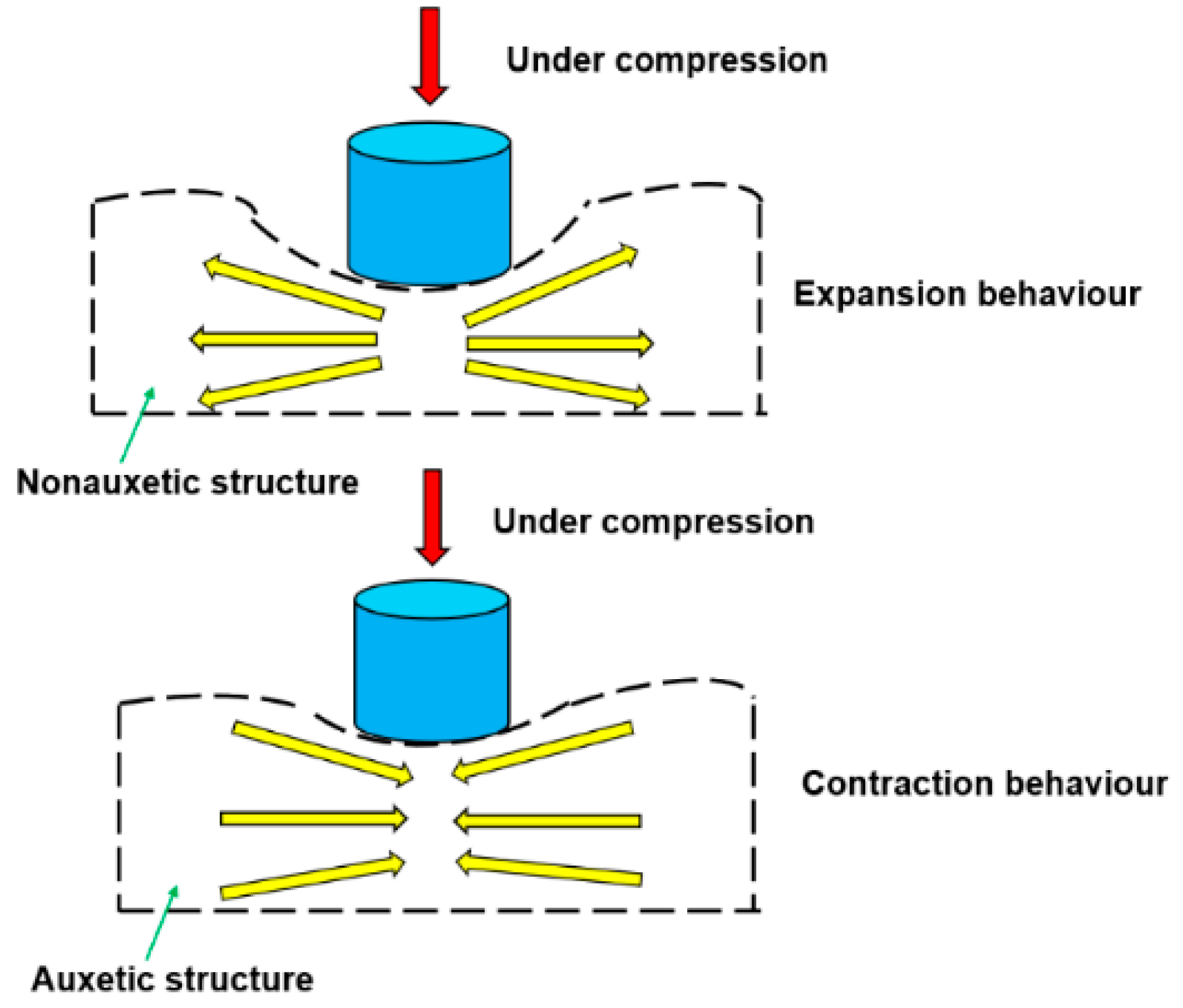

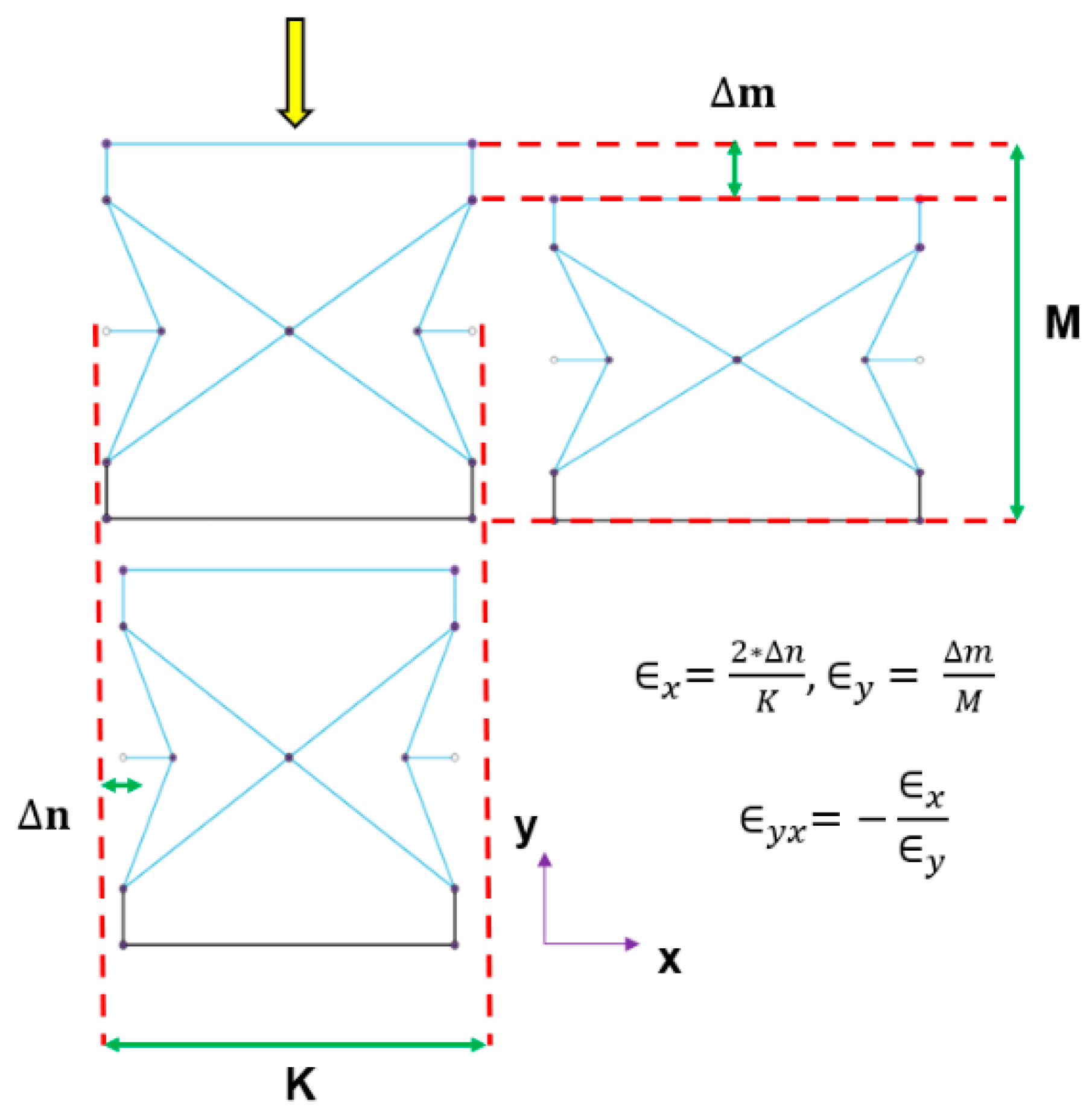



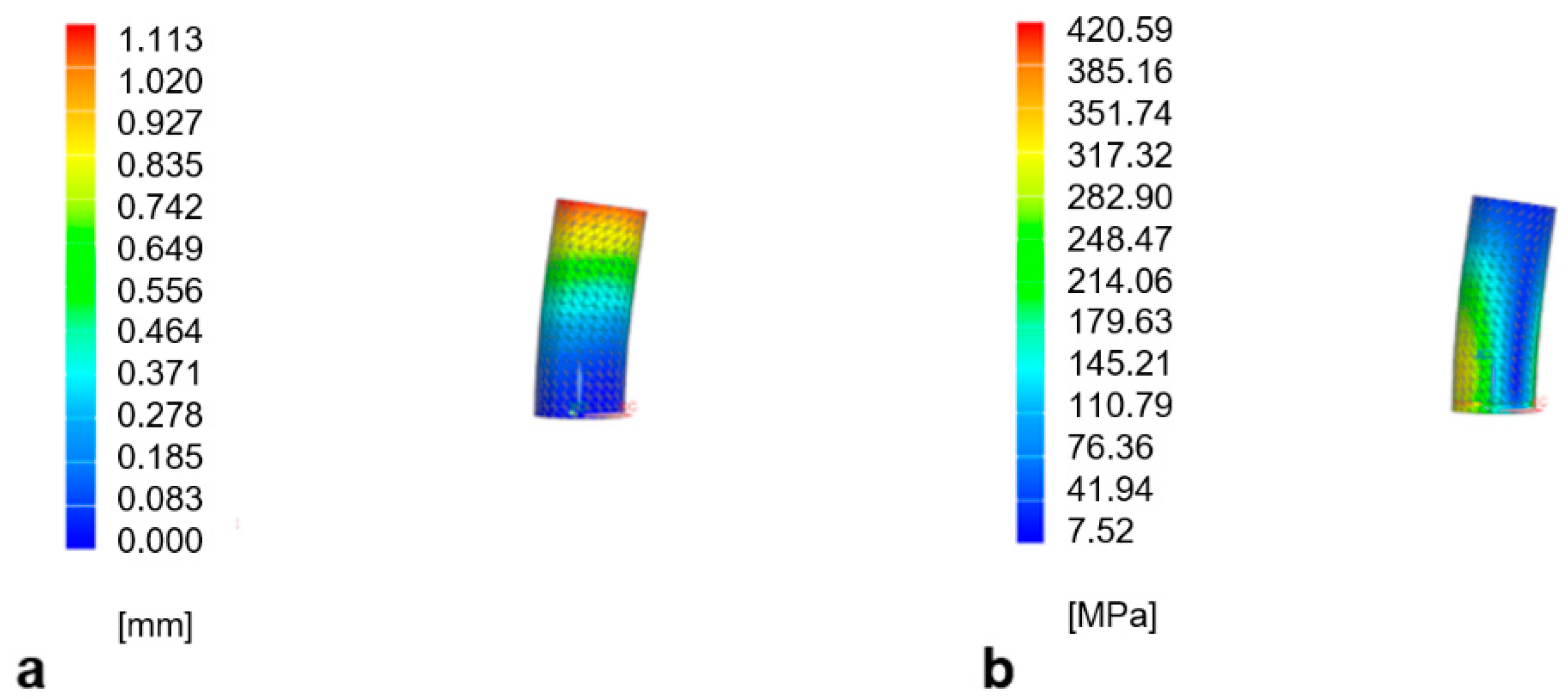

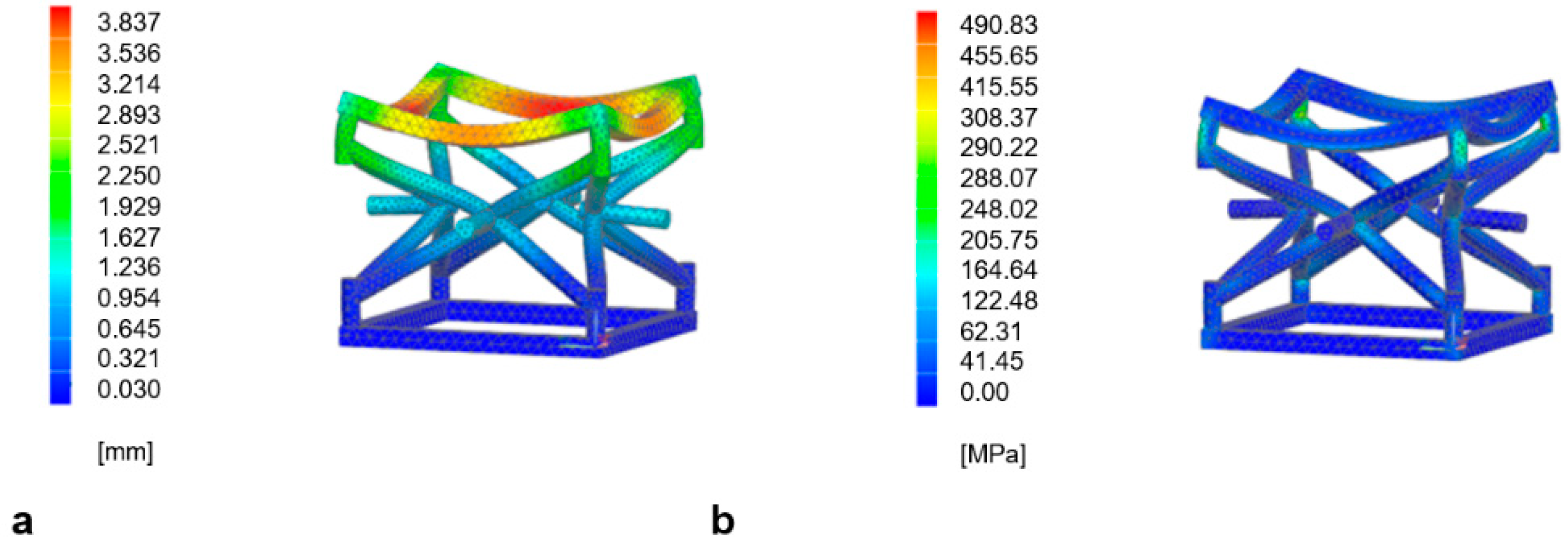

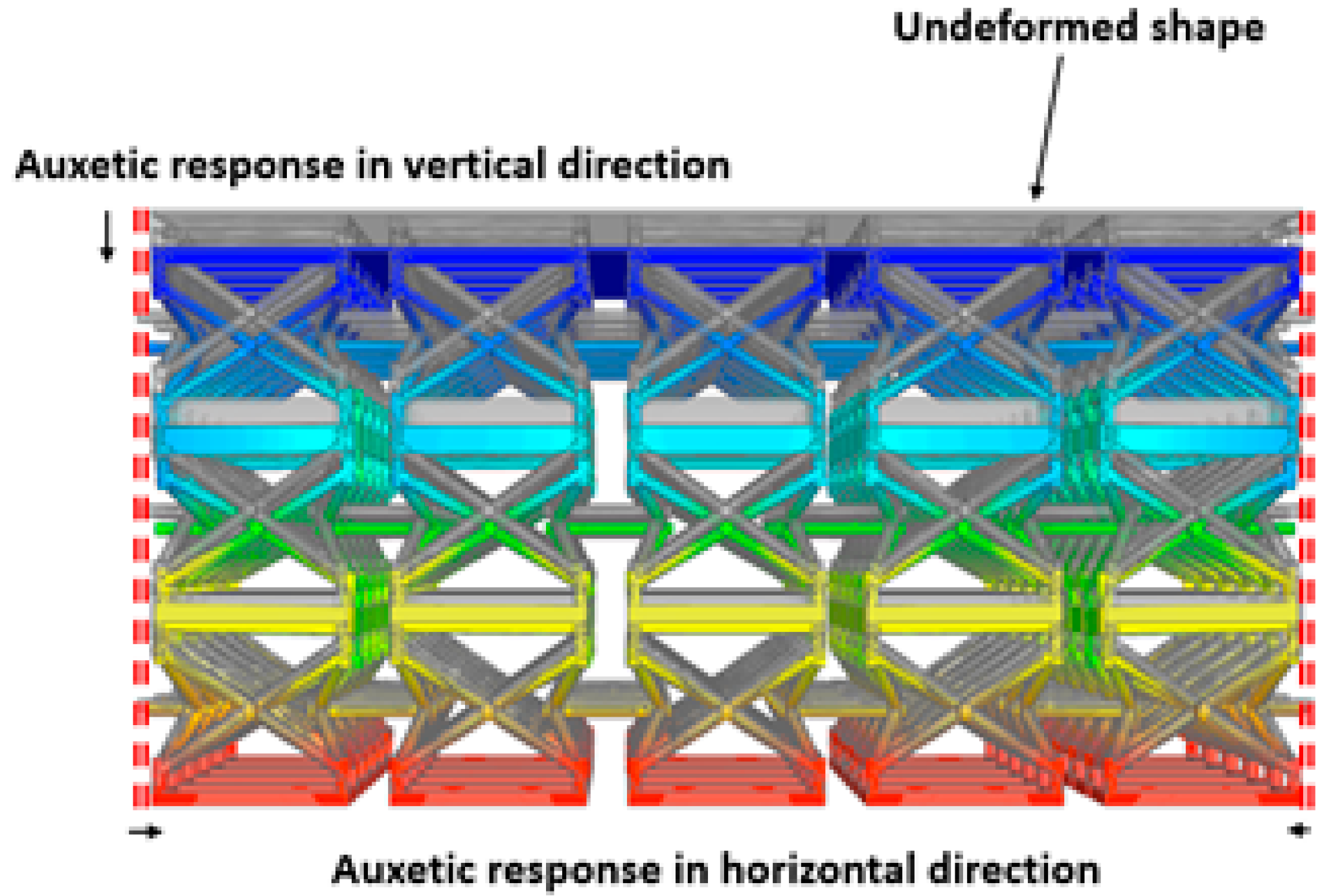


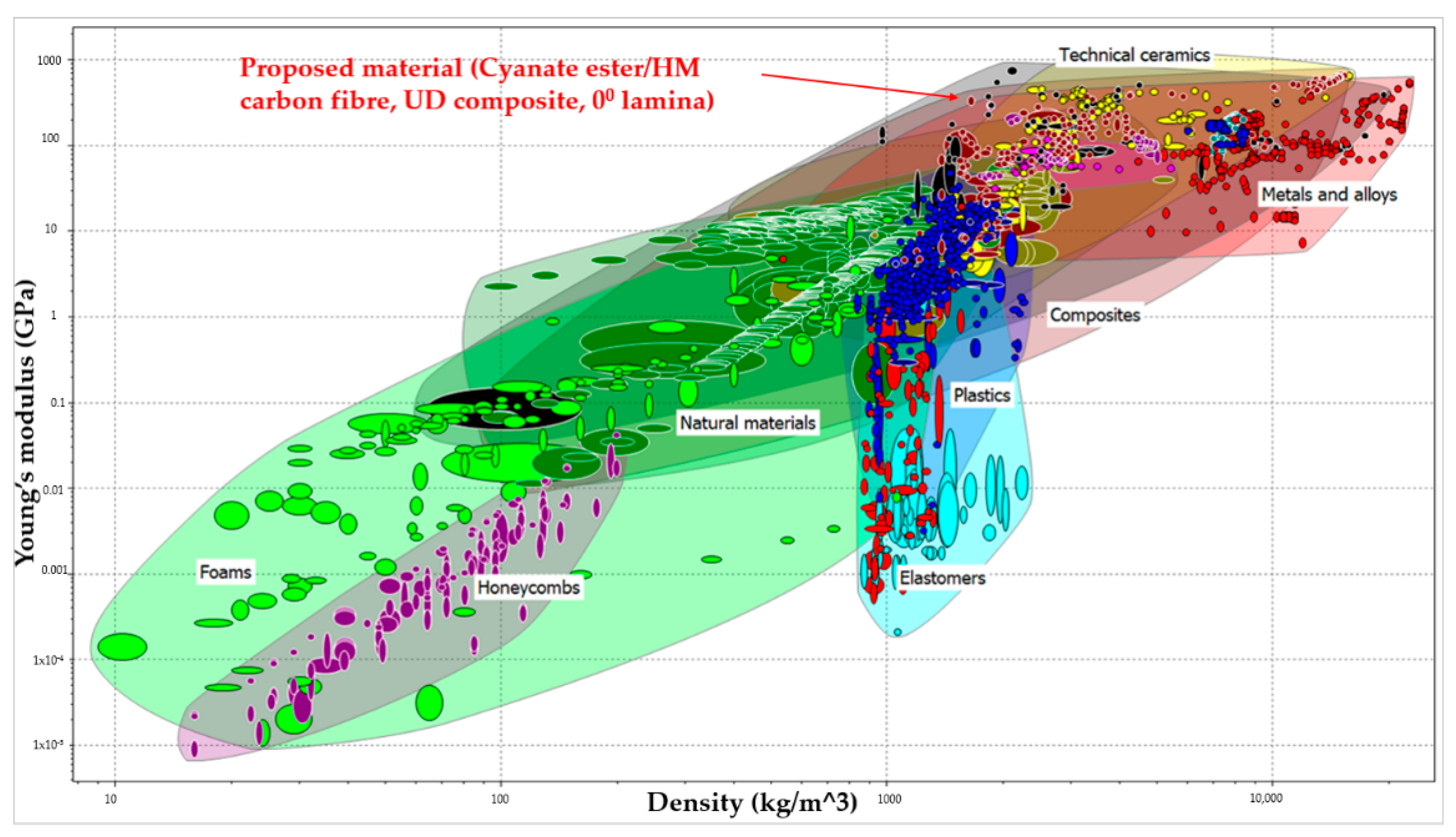
| Vertical Column | Diagonal Column | |
|---|---|---|
| < | 47.60 > 20 | 47.60 < 67.04 |
| Theory | Johnson | Euler |
| (N) | 34.00 | 9.68 |
| (N) | 37.17 | 37.17 |
| (MPa) | 19.21 | 5.47 |
| (MPa) | 21.00 | 21.00 |
| Mode of failure | Buckling | Buckling |
| Vertical Column | Diagonal Column | |
|---|---|---|
| Buckling load factor, | 109.55 | 9.74 |
| (N) | 1 | 1 |
| (N) | 109.55 | 9.74 |
| Relative error , compared to analytical results | overestimation | 0.62 |
| Type of failure | Buckling | Buckling |
| Simulation | Young’s Modulus, E (GPa) |
|---|---|
| Model 1 | 200 |
| Model 2 | 300 |
| Proposed model | 350 |
| Model 3 | 400 |
Publisher’s Note: MDPI stays neutral with regard to jurisdictional claims in published maps and institutional affiliations. |
© 2021 by the authors. Licensee MDPI, Basel, Switzerland. This article is an open access article distributed under the terms and conditions of the Creative Commons Attribution (CC BY) license (https://creativecommons.org/licenses/by/4.0/).
Share and Cite
Sengsri, P.; Kaewunruen, S. Local Failure Modes and Critical Buckling Loads of a Meta-Functional Auxetic Sandwich Core for Composite Bridge Bearing Applications. Appl. Sci. 2021, 11, 10844. https://doi.org/10.3390/app112210844
Sengsri P, Kaewunruen S. Local Failure Modes and Critical Buckling Loads of a Meta-Functional Auxetic Sandwich Core for Composite Bridge Bearing Applications. Applied Sciences. 2021; 11(22):10844. https://doi.org/10.3390/app112210844
Chicago/Turabian StyleSengsri, Pasakorn, and Sakdirat Kaewunruen. 2021. "Local Failure Modes and Critical Buckling Loads of a Meta-Functional Auxetic Sandwich Core for Composite Bridge Bearing Applications" Applied Sciences 11, no. 22: 10844. https://doi.org/10.3390/app112210844
APA StyleSengsri, P., & Kaewunruen, S. (2021). Local Failure Modes and Critical Buckling Loads of a Meta-Functional Auxetic Sandwich Core for Composite Bridge Bearing Applications. Applied Sciences, 11(22), 10844. https://doi.org/10.3390/app112210844







